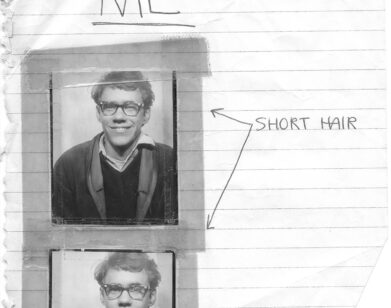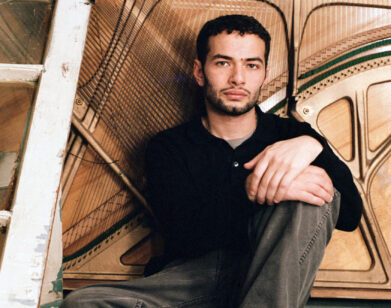Performing with Pipilotti
As one of the first experimental video artists, Pipilotti Rist has become known for her effervescent films and immersive installations that warp the human body and submerge the viewer in a world that is uniquely “Pipi.” Sound maintains a large role within the Swiss artist’s videos, and her interest in music can be traced to the late ’80s and early ’90s, when she was a member of the all-female band Les Reines Prochaines. This month, Rist (whose adopted first name comes from the children’s character Pippi Longstocking) returned to her musical roots with the premiere of a new video work, commissioned for the inaugural Nancy A. Nasher and David J. Haemisegger Family SOLUNA International Music & Arts Festival in Dallas, Texas.
“It’s a big risk,” Rist says in regard to the festival’s combination of the art world with classical music. “There are different rituals and different audiences, but if you want something [innovative], you have to try new collaborations.”
Keeping the festival’s theme, “Destination: America,” in mind, Rist created her video also knowing that it would accompany the Dallas Symphony Orchestra’s Hollywood Exile two-night concert. Last weekend, as the Symphony played Miklós Rózsa’s “Andante for Strings,” Rist’s video was projected onto a backdrop. Her vibrant montages of plants, sky, water, and snow were interspersed with a man playing the violin in trance-like state, while the video’s gelatinous black border crept around the screen’s edges.
Following the dress rehearsal for Hollywood Exile at Dallas City Performance Hall, we sat down and spoke with the artist.
HALEY WEISS: I’d like to talk about how you got involved with this piece, and when you chose the music that the video would accompany. How did the collaboration work with the orchestra?
PIPILOTTI RIST: They contacted me by email and asked if I would be interested. They explained their concept—that it’s about musicians from Europe who, for different reasons, ended up in California. They proposed two different pieces by [Igor] Stravinsky and [Miklós] Rózsa. I chose Rózsa—the lesser known, but he’s quite well known among music fans—and the symphony said, “We are so happy to play him rather than stay on the beaten track.”
WEISS: I’m curious as to how you proceed after a piece of music is chosen. Do you immediately start filming, or do you map out the entire sequence?
RIST: Every work is completely different. Sometimes the music is first, sometimes it’s parallel, and sometimes the music is after. There’s no rule. Music goes differently to your emotions. With music you can create different spaces and feelings easier than you can with the visual—maybe not easier, but in a way, it’s more seductive.
WEISS: You’ve made films, music videos, and installations in the past, so do you see pairing a video with an orchestral performance as bridging those forms? In a theater, everyone is watching collectively from the audience, but it’s still like an installation because everyone is encapsulated in this dark space together.
RIST: Yes, as you said, everyone is looking in one direction, but then with the live musicians it’s like everybody is a room in itself. It’s unlike a museum where everything is prepared—the projector, the player—and people come into the room. Even if it’s multidimensional or operating in different directions, the visitor is, in a way, the center. But in a concert, you sit and you identify with the musician. You dream about how their synapses play, and everybody, I repeat this, is a room in itself.
WEISS: Something I didn’t consider prior to the performance was the way the orchestra becomes a visual element; there’s this swelling motion of the violinists that becomes part of your visual piece. When the swans appear in the video, their necks echo the swaying motion of the violins and bows. Is this something you anticipated, or something you discovered when you got into the space?
RIST: I anticipated it in that I tried to pretend to be one of the musicians in the orchestra. [both laugh] I’m interested in how their brains work, like how to know when exactly to put your finger down and up [when playing an instrument]. I tried to make a piece that is subservient [to the orchestra] by pretending to be in the head of one of the musicians.
WEISS: Some of the scenes in the video were shot from angles, as if the camera was emerging from the Earth. There’s this scale where a plant becomes as big as a person. I think that speaks to the relationship between the landscape and us.
RIST: The main reason for civilization is that life is more comfortable. In a way, houses are there to protect us from rain, cold, and heat; cars are there to overcome distances. Culture is the exception. Music, art, and all of the different cultural expressions are not going in that direction. They’re not about comfort; they’re about understanding each other. So by listening to what Rózsa imagined, this group comes together and materializes his imagination. That has a goal other than comfort.
WEISS: The works within this concert, and as part of the theme Destination: America, seem to be using immigration by composers, like Rózsa, to tie people together.
RIST: Rózsa had a kind of double life. He made so many incredible film scores, like Ben-Hur, but he never stopped writing concerts. Here that’s turned around. The image tries to go behind the musicians. Rózsa had been working on a film in England—he was already out of Hungary and out of Germany—and then the war broke out and it was not comfortable to work on the film anymore, so the whole crew left. So he was not a direct refugee, but he became an indirect refugee—he came to America and never went back. The film industry helped people like Rózsa to survive and prosper and to do other things besides film scores. A lot of people in the film industry lead double lives.
WEISS: It’s what allows them to make a living and do their own work…What’s your relationship to nature when you’re filming these videos? Is it all planned ahead of time, or are there moments when you’re in nature and you think, “I just have to film this?”
RIST: I would say it’s half and half. I have precise ideas but I also try to embrace the coincidences. I work mostly alone, so this video was made from scratch. There’s a lot of trial and error. But in the system, when we speak of Hollywood, if you need a big crew, you have to be prepared extremely well because when everyone is there it has to work. The smaller the group, the more trial and error and experimenting you can do. I do a lot of garbage. [both laugh] The digital also helps. When it was celluloid [film] it was material; you could not waste it.
WEISS: Has the video editing process changed a lot for you over the years? Do you feel like you have more control over the editing now, using electronic media?
RIST: First I did animation films, when I was young, in time-lapse. And then in the ’80s I went directly to video. The main reason for that was that I could control all the steps. That’s my agenda, I want that, but there are also artists who like to work in big groups and delegate.
WEISS: What is the afterlife of this piece? After it being a site-specific performance, in the future would you show it as a video installation paired with the music?
RIST: Yes, actually, they’re recording the performance on both nights and will mix the best of each to make the whole piece, and I get the right to use it. I have to work on it more to make this life [of Rózsa] and to stage the people who come into the room. I want to try to come away from that one directional, clear rectangular form. It’s not used because it’s the most beautiful form; it’s just the practical thing. That’s why our TVs are rectangles. Even in modern architecture, they want us to believe, “That’s the nicest, most beautiful thing.” I love modern architecture, but actually it’s that they cannot afford amorphous shapes or ornaments. Of course I’m always in awe of and respect humans for their ability to plan, but sometimes, good intentions are lost along the way. And often the way becomes the goal.
WEISS: You were speaking about being able to control the video through planning and experimenting, but how does it feel to let go and give the video to the orchestra?
RIST: It’s like a love affair; you try to be in sync. Sometimes, for one second, you are completely one, and then you have to let go. For me it’s also a philosophical experience. If it’s in sync, I cannot anymore control it.
FOR MORE INFORMATION ON THE ARTIST, VISIT HER WEBSITE, AND FOR MORE ON SOLUNA, CLICK HERE.







